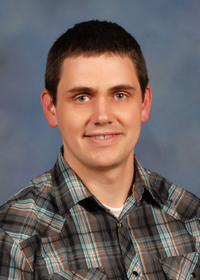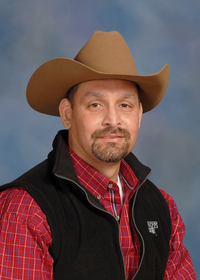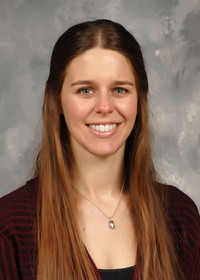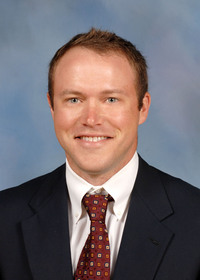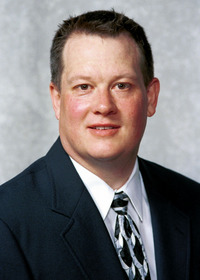The Plant Doctor: Large (Brown) Patch of Warm-Season Turfgrasses
Large (Brown) Patch

Most common seasons
Spring and fall, when turf is emerging from or entering dormancy.
Weather
Cool nights, warm days with rains or heavy dews.
Turf types affected
All warm-season turfgrasses, including St. Augustinegrass, centipedegrass, bermudagrass, and zoysiagrass
Quick symptoms
Brown, round patches in the lawn; leaf tips brown or red.
Quick Symptoms and Background
Large patch is the most common lawn disease in Mississippi during the spring and fall. It is characterized by circular patches with brown or smoky gray outer edges. The circular patches may continue to grow to 20 feet or more in diameter and may intersect other patches, creating complex patterns (Figure 1). In larger patches, the inside of the patch may begin to turn green again. The patches often occur at the same location year after year, usually in low areas or where dew or moisture stays for longer periods, such as shaded areas.
This disease is caused by a fungus, Rhizoctonia solani, which also causes diseases of many agricultural and horticultural crops. The fungus is actually a weak pathogen of warm-season turfgrasses, attacking them during emergence from or entering into winter dormancy, when they are at their weakest. This is why large patch of St. Augustinegrass, centipedegrass, bermudagrass, and zoysiagrass (warm-season turfgrasses) is most common in the spring and fall, and is usually not active during the summer, when the warm-season turfgrasses grow best. This disease has been called many names, including “large patch,” “large brown patch,” “brown patch,” and “Rhizoctonia brown patch.”
The Rhizoctonia solani fungus also attacks cool-season turfgrasses, such as tall fescue, bentgrass, and ryegrass, but these plants are weakest in our summer heat, so it is a summer disease on them. As you might guess, the disease symptoms are different on cool-season grasses than on warm-season turfgrasses. This publication discusses the disease caused by Rhizoctonia solani on warm-season tufgrasses.
Disease Cycle and Symptoms
While the fungus Rhizotonia solani is present all year in the soil, certain conditions are needed for disease to occur. Extended dew periods, rains, or excessive irrigation must be present because the disease is often worse in low, wet areas. Relatively cool temperatures (60 to 75 °F) facilitate the disease while the cool nights and warm days typical of spring or fall may prolong it. At temperatures of 75 °F and above, and under low moisture conditions, the activity of the fungus decreases. High nitrogen fertility, especially in response to early fertilizer applications, increases turf susceptibility to the disease. A weak host, such as a warm-season turfgrass emerging from and entering winter dormancy, favors infection.
The first symptom of large patch most people notice is one or more circular, light green patches that may range in diameter from 2 inches to about 2 feet. These will usually start where patches have grown in previous years, in low areas, or in areas where dew and moisture presence is increased. The patches grow from the center outward and may spread rapidly or slowly, depending on moisture and temperature conditions. Patches grow as long as conditions are favorable and may spread out 20 feet or more. A green recovery may be seen in the centers of some of the greater large patches. In the fall, patch borders are usually brownish to gray. In the spring, as the grass starts to grow and if the weather remains wet and mild, the patch may turn yellow, gray, and then brown. The color of the outside edge of an actively growing patch is usually a cinnamon brown (Figure 2).

The fungus begins its attack at the base of leaf sheaths where the leaves attach to the rope-like stolon (Figure 3). The base of the leaves turns dark brown to almost purple and is soft when conditions are moist and the disease is active. In the absence of moisture, the base will turn tan or reddish-brown and harden. Because the base of the leaf is rotting, the flow of moisture and minerals to the upper leaves is cut, and the top of the leaf turns color before dying and turning brown.

The upper leaves of St. Augustinegrass will generally turn yellow, whereas the upper part of centipedegrass leaves turn reddish before dying. Centipedegrass and zoysiagrass recover more slowly from large patch than bermudagrass. St. Augistinegrass is in between. In general, the more severe the patch, the longer the recovery. Turf can be so damaged that you may be able to see the outline of the patch most of the year, even though the pathogen is not active.
One test to confirm the disease is to walk to the edge of the patch, pinch the tip of a symptomatic grass leaf, and gently tug. The leaf should come off in your hand and the base will be brown to tan, if the disease is large patch. Try this with multiple leaves around the outside of the patch.
If the leaves and stolons come up together, you might have take-all root rot (see Extension publication P2384 The Plant Doctor: Take-all Disease of Turfgrasses for more information). If the plant and roots come up without no stolons, you may have anthracnose. Both of these diseases are typically found during hot weather.
The pathogen can move in flooding heavy rains (Figure 4), or perhaps in diseased tissue moved by lawn equipment.
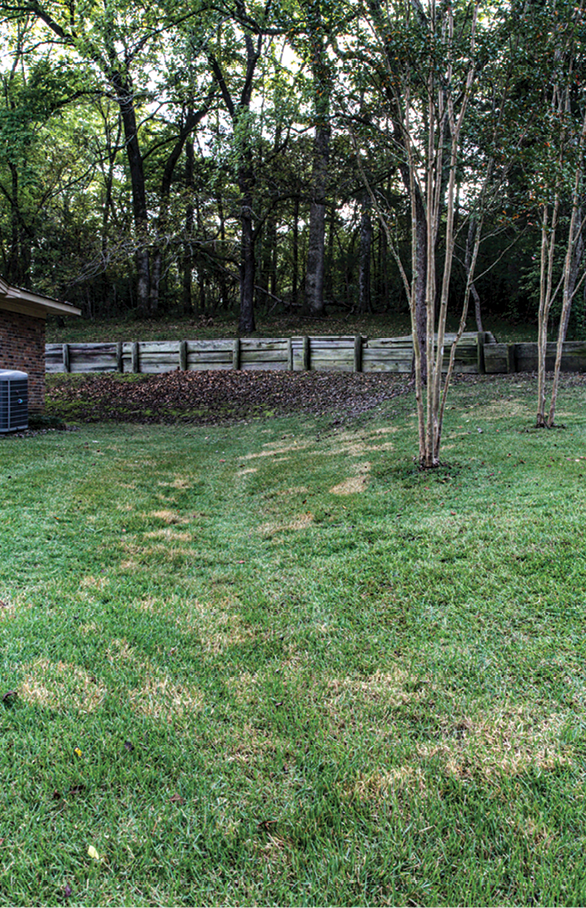
You can have the disease professionally diagnosed and receive a full report and recommendation for a small fee. Collect a 6-by-6-inch sample, including 2 inches of soil and roots, from the edge of the disease area where it fades into healthy turf. Wrap the sample in dry newspaper, place it in a plastic bag, box it, and send the box to our diagnostic laboratory. Please see http://extension.msstate.edu/lab for the current address and fees. Results are usually available within 3 to 7 days of receiving the sample and payment. Read M1230 Plant Diagnostic Laboratory for more detailed submission instructions.
Prevention is the best method of disease control. To prevent large patch or other lawn diseases from developing, practice the following disease-control procedures:
- Use varieties adapted for your area.
- Manage your lawn properly by using recommended practices for watering, mowing, fertilizing, and removing thatch.
- Too much nitrogen fertilizer (water-soluble nitrogen sources) promotes a lush turf that is readily attacked by many plant diseases, including large patch. Because of television advertising campaigns, many fertilize their lawn too early and are encouraging the large patch disease. See P1322 Establish and Manage Your Home Lawn for more guidance on fertility and fertilization, but a general rule of thumb is that you should not fertilize until you have mowed your warm-season turfgrass lawn at least twice. Earlier fertilization will feed more weeds than grass, and also make large patch worse.
- Watering late in the afternoon or mid-morning lets the grass remain wet for long periods of time, encouraging disease development. Water infrequently and deeply at times that do not extend the leaf wetness period.
- Thatch is the buildup of grass and plant debris in the root and crown areas of the turf. Too much thatch creates a favorable environment for the growth of many disease-causing fungi and, at the same time, an unfavorable environment for turf plants. Thatch gives the lawn a spongy feeling. If you can wiggle your finger through more than a half-inch of grass before contacting the soil, you probably have too much thatch. Thatch is most common in Zoysiagrass but can occur in most turf-types. Large patch is typically a disease that occurs in the spring and fall, but has been observed as late as mid-July in overwatered, heavily thatched St. Augustinegrass lawns.
- If your lawn has a history of large patch, then you should be proactive in preventing its development. Proper fall treatments may reduce the need for spring applications. There are several ways to approach this. For the first option, you need a soil thermometer or access to nearby weather data through http://deltaweather.extension.msstate.edu/stations. The second option does not require these tools, but the use of weather data or a soil thermometer will likely provide the best results.
Figure 5 shows experimental turf plots at Mississippi State University in late October. The left area was treated in mid-September after soil temperatures at a 2-inch depth read 70° F, or slightly less, for three consecutive days. The turf on the right side was not treated. The difference is clear.
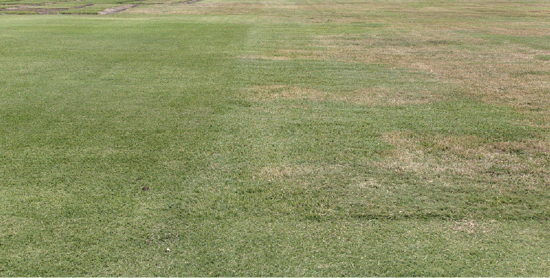
Professional turf managers use thermometers or weather station information to determine fungicide application timing.
- Use inexpensive soil thermometers or weather station data to watch soil temperatures at a 2-inch depth. The first fungicide application is made after the 2-inch depth soil temperature has been at 70° F or cooler for three consecutive days.
- Reliable weather station data can be accessed on the Extension website. Not all stations have soil thermometers, but many do.
- Find your nearest weather station and locate their 30-Days Table. Scroll to the right to find the temperature readings at the 2-inch depth that occurred during the day. There is a maximum temperature and a minimum temperature reading for each day. The third and fourth columns are the time at which the maximum and minimum temperatures occurred. These are followed by a fifth column, “Soil Temperature Observed at 2-inch depth.” This is an instantaneous reading of 2-inch soil temperature at 7 a.m. standard time. The temperatures from this column should work as well as the minimum morning soil temperature.
- If you live in an urban area, your soil temperatures are likely to be slightly warmer than those recorded by these weather stations.
- When using a thermometer, take the 2-inch depth soil temperature around 7 a.m.
If you have neither a soil thermometer nor comparable weather station information, then make an estimate using the following tips:
- In the fall:
- When the forecaster announces the first cool evenings of fall, apply a fungicide to and around the areas where large patch has occurred before.
- ▪Follow label directions until the turf enters dormancy. The label often provides a range of days for the reapplication interval. Applications in both the spring and fall may be spaced further apart during dry weather, and should be more frequent during wet weather and cool temperatures. Proper fall applications may reduce the need for spring treatments.
- In the spring:
- ▪Watch for rainy periods during warm days followed by cool nights. Pay special attention during the period when the grass is just starting to green.
- Apply a fungicide to and around the areas where large patch has occurred before. Follow label directions for repeat applications until you have mowed the lawn twice. The label often provides a range of days for the reapplication interval.
- Applications in both the spring and fall may be spaced further apart during dry weather, and should be more frequent during wet weather and cool temperatures.
- Because the disease is near the soil, apply liquid fungicides in enough water to equal 3 gallons of water per 1,000 square feet. This will carry the fungicide into the area of the plant that can best absorb it and best fight the disease. Granular formulation should be applied when no moisture is on the leaves. Follow label directions.
- There are four active ingredients for residential use readily available in garden stores and co-ops. Two of the active ingredients are members of the same class of chemistry. A 2010 trial showed that one of these, myclobutanil (both granular and liquid formulations) burned turf in temperatures higher than 80°F. The other, propiconazole, was not in the trials, but it has been reported to cause similar burns when it is used on warm-season turf at similar temperatures. These products are:
- Myclobutanil. Sold as Fertilome F Stop (0.39% granular, 8
- Propiconazole. Sold as Bioadvanced Fungus Control for Lawns (0.51% granular or a 2.42% ready-to-spray), Bonide Infuse Systemic Disease Control (1.8% liquid or ready-to-spray), and Fertilome Liquid Systemic (1.55% liquid).
- Thiophanate-methyl. Sold by Bonide as Infuse Lawn & Landscape Granules. This fungicide, as well as the fourth one, azoxystrobin, should not cause any “burn” or turf phytotoxicity. For pollinator safety, use it on lawns with no or only a few flowering weeds.
- The fourth active ingredient is a granular formulation of azoxystrobin. This is sold in a 10-pound bag as Scotts Disease EX Fungicide or in a 30-pound bag as Heritage G. Both are labeled at 2 pounds of product per 1,000 square feet for preventive usage and 4 pounds for curative usage. Heritage G can be purchased and used by residential owners (it is not a restricted-use fungicide, nor is it only for professional use), but it is used by professionals. Because this product is mostly used by professionals, it is not generally carried by garden stores and must be ordered.
The information given here is for educational purposes only. References to commercial products, trade names, or suppliers are made with the understanding that no endorsement is implied and that no discrimination against other products or suppliers is intended. Products, especially for residential use, change frequently. This information was accurate at the time of publication.
Publication 3743 (POD-02-22)
By Alan Henn, PhD, Extension Professor, Biochemistry, Molecular Biology, Entomology and Plant Pathology.
The Mississippi State University Extension Service is working to ensure all web content is accessible to all users. If you need assistance accessing any of our content, please email the webteam or call 662-325-2262.




